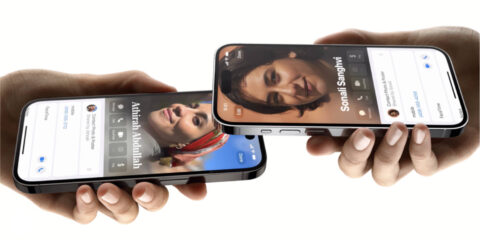It’s been a strange week for iPhone news, with several bizarre stories making the rounds, giving us another chance to remind you not to believe everything you scroll past in your news feed. We’ve seen a combination of fake news, technical misunderstandings, and genuinely baffling glitches on display – if you missed them, buckle up.
Case #1: the magic mirror
You might have seen the iPhone photo that went viral last week of a woman trying on a wedding dress. She claims the image hasn’t been doctored in any way, yet the shot includes two mirrors, both of which show a different pose than she’s actually pulling. Glitch in the matrix or rare machine learning blunder from Apple’s Camera app?
Neither. Although many took this is a sign that iOS goes overboard with A.I., making unwarranted changes to your photos on the fly, the truth is much simpler. According to @ayfondo, the most likely explanation is that the image was accidentally taken in panorama mode, which stitches together images taken over several seconds, accounting for the differing poses across the shot. The resolution of the image matches that of panorama mode.
Another solution is simply that the original poster mocked this “glitch” up on purpose to garner more views. If that’s the case, it certainly worked!
Case #2: silent alarm activated
Similarly, a TikTok user known as @angelegsophia posted a cry for help, claiming that her iPhone has mysteriously sounded an alarm at exactly 9:25am every day for the past five years, despite no such alarm existing in her Clock app. She says this strange behavior has persisted across several new devices and even goes off when she has the Clock app uninstalled.
Although nobody in the TikTok comments seems to have solved this mystery just yet, to us it seems like a clear case of a rogue third-party app firing off a timed alert. A factory reset should do the trick, although she’s averse to trying it – so the next best solution would be to comb through installed apps and either delete or disable notifications for anything inessential.
Case #3: police scaremongering
Lastly, we have something which is less mystery, more misinformation. Various police departments around the US have been issuing warnings to parents to deactivate the NameDrop feature on their kids iPhones. They claim it could be used by “scammers and thieves” to steal personal information from a nearby device, which is a scary prospect for sure.
But it’s just not true. NameDrop works by putting two iPhones close together – as in, almost touching. It won’t trigger from further away. Even when the feature is triggered, it then requires both parties to consent to sharing by unlocking their device and pressing a share button. Even then, only the information listed in your contact card is shared, likely nothing more than you’d put on a business card.
If a bad actor is somehow able to both unlock and physically touch your iPhone, there’s plenty worse things they could do than copy your name and phone number.



